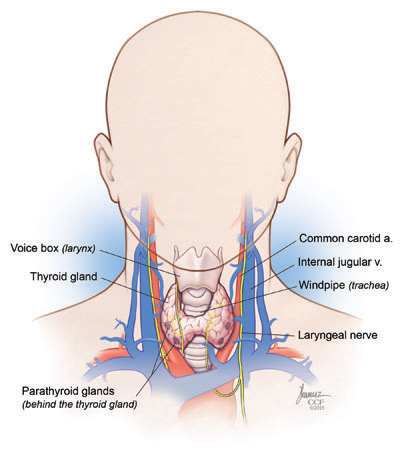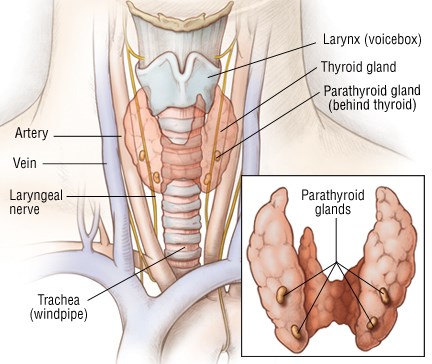If the Thyroid and Parathyroid Glands Are Surgically Removed
It implies a thorough knowledge of the normal anatomy and its many variants. To treat these problems patients may require removal of the thyroid gland known as thyroidectomy.
A thyroidectomy is an operation to remove all or part for the thyroid gland.

. Parathyroid gland preservation is technically more demanding than avoiding recurrent laryngeal nerve injury. Traditional parathyroidectomy involves a small incision in the front of the neck. This allows the parathyroid glands to be differentiated from surrounding thyroid fat or lymph nodes and more easily identified5 In randomized clinical trials NIRAF has been shown to improve the identification of parathyroid glands during thyroid surgery and decrease the rates of parathyroid autotransplantation inadvertent parathyroid removal and postoperative.
If you need only part of your thyroid removed partial thyroidectomy your thyroid may work normally after. Hemi Thyroidectomy This is the removal of half of the thyroid gland. A total thyroidectomy removes the entire thyroid and the thyroid tissue.
The human body has four small butterfly-shaped parathyroid glands located in the neck. How much of your thyroid gland is removed during thyroidectomy depends on the reason for surgery. Total Thyroidectomy This is the removal of the whole thyroid gland.
Low calcium levels Behind the thyroid gland sit 4 parathyroid glands. Surgical anatomy of the parathyroid glands. Its also known as a parathyroidectomy.
The standard parathyroid operation is the old way of performing parathyroid surgery. Crucial anatomical landmarks are the common subcapsular or very adherent position of some superior and inferior. A thyroidectomy is a common but major surgery with serious risks and potential complications.
Parathyroidectomy This is the removal of some or all of the parathyroid glands. Parathyroid surgery clinically referred to as parathyroidectomy is a procedure thats most often used to treat primary hyperparathyroidism pHPT in which the parathyroid gland produces too much parathyroid hormone PTH. It is the treatment for a number of different thyroid disorders including thyroid cancer goitre thyroid nodules and Graves Disease.
Total thyroidectomy removing all of the thyroid gland lobectomy or hemithyroidectomy removing half of the thyroid gland near-total thyroidectomy removing most of the thyroid gland but leaving a little tissue on one side occasionally isthmusectomy removal of the central part of the thyroid gland is. However newer transoral through the mouth procedures leave no visible scar and may be an option. Because the surgery is usually done using the minimally invasive technique the.
Problems affecting the parathyroid glands can cause an imbalance of calcium and require removal of one or more of the glands. We aimed to establish the incidence of parathyroid gland excision during surgery for thyroid. Surgery to remove the parathyroid gland is usually the only way of treating primary hyperparathyroidism.
They do this by controlling calcium loss from the bones and kidneys and calcium absorption from the intestine. See reviews and locations. Parathyroid gland removal refers to a type of surgery done to remove these glands.
The removal of one or two parathyroid glands results in a condition called hypocalcemic tetany. There are four parathyroid glands in the body and they produce parathyroid hormone PTH. This surgery might be used if.
One is for instruments and the other is for a camera. Your surgeon will make a small cut 1 to 2 inches. Find and book the best doctors specialising in parathyroid gland surgery insured by Simply Health in Hove.
In around 3 people per. Why is thyroid or parathyroid gland surgery needed. The main types of thyroid surgery are.
Parathyroidectomy is the surgical removal of the parathyroid glands. This is done to remove a tumor of the parathyroid gland. Use of a meticulous surgical technique and dissection close to the thyroid gland aiming at preservation of the intact blood supply to the parathyroids and keeping away from unnecessary manipulation of parathyroids in due course of the dissection are well established factors contributing to the reduced prevalence of temporary and permanent hypocalcemia.
Thyroidectomy is used to treat thyroid disorders such as cancer noncancerous enlargement of the thyroid goiter and overactive thyroid hyperthyroidism. It starts with a tingling sensation or numbness in your fingers or toes. A thyroidectomy is the surgical removal of a diseased thyroid gland.
Watch Surgeon Professor Neil Tolley at Imperial College in London talking about thyroid and parathyroid surgery httpsyoutubeYOkM98efeio. Calcium is an important mineral in the blood that regulates the way your nerves and muscles work. This results in a low blood calcium level which can cause symptoms such as pins and needles in your fingerstoes and around your mouth.
Very rarely primary hyperparathyroidism can be caused by cancer of a parathyroid gland. The thyroid gland can become overactive develop nodules or lumps which grow causing a large thyroid gland known as a goitre or sometimes the nodules or lumps are cancerous. The parathyroids are four glands each about the size of a lentil that sit behind the thyroid gland in the lower part of the neck.
A large incision is made in the neck the muscles of the neck are retracted sideways and the thyroid gland is loosened up and moved aside to allow the surgeon to identify the four parathyroid glands which reside moderately deep in the neck behind the thyroid. Thyroidectomy is a commonly performed operation for the treatment of thyroid disease. There may be spasms of the muscles of the hands causing wrist drop.
This procedure takes about 1 hour. We will be monitoring your blood. Your surgeon will make two small cuts in your neck.
Thyroid surgery involves removing half. Women are more likely to develop primary hyperparathyroidism than men and most people who develop it are over 60. Parathyroid glands control the level of calcium in the blood.
Surgery to remove one or more parathyroid glands adenoma is the standard treatment for hyperparathyroidism a condition associated with high calcium levels in the blood from parathyroid gland overactivity. This surgery is appropriate when nodules swelling or inflammation affect the entire thyroid gland. A thyroidectomy is a treatment for a variety of diseases disorders and conditions of the thyroid gland.
You may have less invasive treatment options. The one or more parathyroid glands may be surgically removed in case of tumors of the glands. Thyroid gland Parathyroid glands Windpipe This view is from the back of the neck.
These control the levels of calcium in your blood and can become injured during thyroid surgery. Inadvertent removal of parathyroid glands is a recognised complication of this operation and may have consequences on the longterm regulation of calcium homeostasis post-operatively. PTH regulates the bodys calcium and phosphorus levels.
Or 25 to 5 cm on one side of your neck and then remove the diseased gland through it.

Thyroid Parathyroid Surgery Gbmc Healthcare In Baltimore Md

Parathyroidectomy Surgery Risks Side Effects Recovery Time

Parathyroid Disease And Surgery Parathyroidectomy Otolaryngology Specialists Of North Texas


No comments for "If the Thyroid and Parathyroid Glands Are Surgically Removed"
Post a Comment